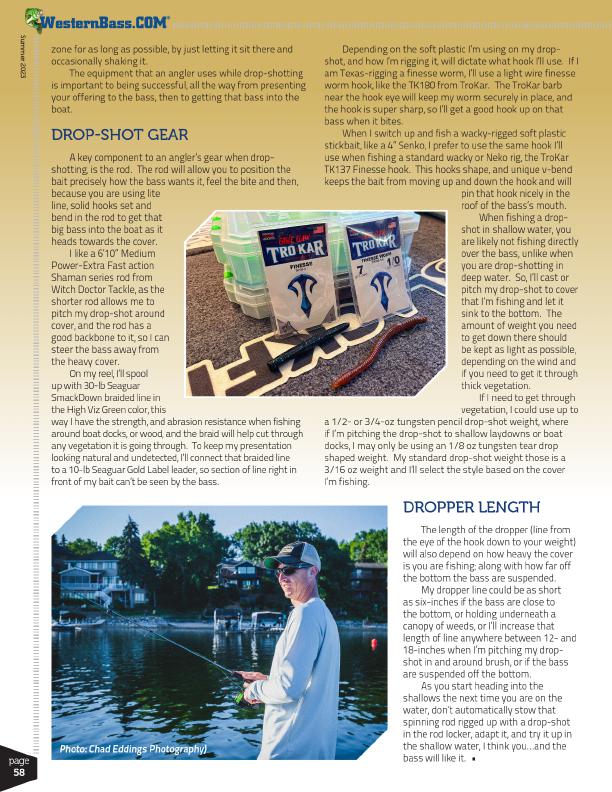
®
Summer 2023
page 58
zone for as long as possible, by just letting it sit there and occasionally shaking it.
The equipment that an angler uses while drop-shotting is important to being successful, all the way from presenting your offering to the bass, then to getting that bass into the boat.
DROP-SHOT GEAR
A key component to an angler’s gear when drop- shotting, is the rod. The rod will allow you to position the bait precisely how the bass wants it, feel the bite and then, because you are using lite line, solid hooks set and bend in the rod to get that big bass into the boat as it heads towards the cover.
I like a 6’10” Medium Power-Extra Fast action Shaman series rod from Witch Doctor Tackle, as the shorter rod allows me to pitch my drop-shot around cover, and the rod has a good backbone to it, so I can steer the bass away from the heavy cover.
On my reel, I’ll spool up with 30-lb Seaguar SmackDown braided line in the High Viz Green color, this way I have the strength, and abrasion resistance when fishing around boat docks, or wood, and the braid will help cut through any vegetation it is going through. To keep my presentation looking natural and undetected, I’ll connect that braided line to a 10-lb Seaguar Gold Label leader, so section of line right in front of my bait can’t be seen by the bass.
Photo: Chad Eddings Photography)
Depending on the soft plastic I’m using on my drop- shot, and how I’m rigging it, will dictate what hook I’ll use. If I am Texas-rigging a finesse worm, I’ll use a light wire finesse worm hook, like the TK180 from TroKar. The TroKar barb near the hook eye will keep my worm securely in place, and the hook is super sharp, so I’ll get a good hook up on that bass when it bites.
When I switch up and fish a wacky-rigged soft plastic stickbait, like a 4” Senko, I prefer to use the same hook I’ll use when fishing a standard wacky or Neko rig, the TroKar TK137 Finesse hook. This hooks shape, and unique v-bend keeps the bait from moving up and down the hook and will
pin that hook nicely in the
roof of the bass’s mouth.
When fishing a drop-
shot in shallow water, you
are likely not fishing directly
over the bass, unlike when
you are drop-shotting in
deep water. So, I’ll cast or
pitch my drop-shot to cover
that I’m fishing and let it
sink to the bottom. The
amount of weight you need
to get down there should
be kept as light as possible,
depending on the wind and
if you need to get it through
thick vegetation.
If I need to get through
vegetation, I could use up to a 1/2- or 3/4-oz tungsten pencil drop-shot weight, where if I’m pitching the drop-shot to shallow laydowns or boat docks, I may only be using an 1/8 oz tungsten tear drop shaped weight. My standard drop-shot weight those is a 3/16 oz weight and I’ll select the style based on the cover I’m fishing.
DROPPER LENGTH
The length of the dropper (line from the eye of the hook down to your weight) will also depend on how heavy the cover is you are fishing; along with how far off the bottom the bass are suspended.
My dropper line could be as short as six-inches if the bass are close to the bottom, or holding underneath a canopy of weeds, or I’ll increase that length of line anywhere between 12- and 18-inches when I’m pitching my drop- shot in and around brush, or if the bass are suspended off the bottom.
As you start heading into the shallows the next time you are on the water, don’t automatically stow that spinning rod rigged up with a drop-shot in the rod locker, adapt it, and try it up in the shallow water, I think you…and the bass will like it. •